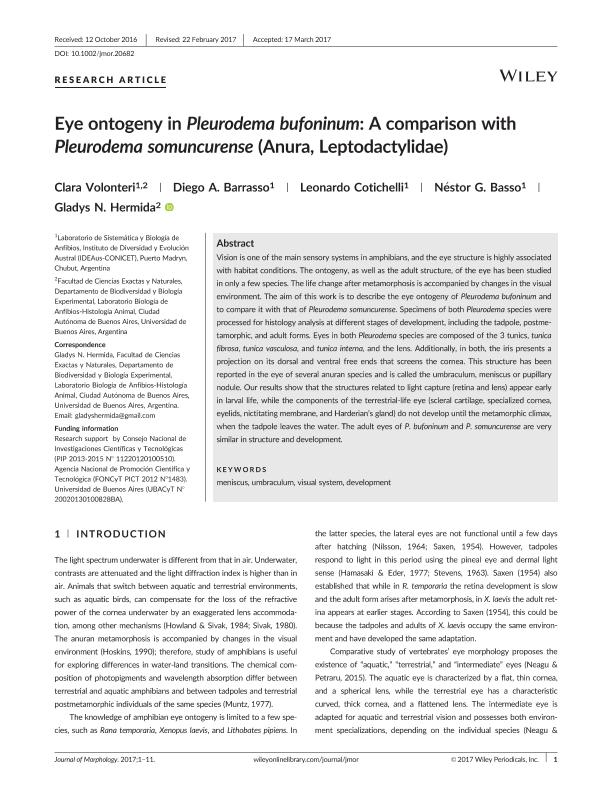Artículo
Eye ontogeny in Pleurodema bufoninum: A comparison with Pleurodema somuncurense (Anura, Leptodactylidae)
Volonteri, María Clara ; Barrasso, Diego Andrés
; Barrasso, Diego Andrés ; Cotichelli, Leonardo
; Cotichelli, Leonardo ; Basso, Nestor Guillermo
; Basso, Nestor Guillermo ; Hermida, Gladys Noemí
; Hermida, Gladys Noemí
 ; Barrasso, Diego Andrés
; Barrasso, Diego Andrés ; Cotichelli, Leonardo
; Cotichelli, Leonardo ; Basso, Nestor Guillermo
; Basso, Nestor Guillermo ; Hermida, Gladys Noemí
; Hermida, Gladys Noemí
Fecha de publicación:
02/07/2017
Editorial:
Wiley-liss, Div John Wiley & Sons Inc
Revista:
Journal of Morphology
ISSN:
0362-2525
Idioma:
Inglés
Tipo de recurso:
Artículo publicado
Clasificación temática:
Resumen
Vision is one of the main sensory systems in amphibians, and the eye structure is highly associated with habitat conditions. The ontogeny, as well as the adult structure, of the eye has been studied in only a few species. The life change after metamorphosis is accompanied by changes in the visual environment. The aim of this work is to describe the eye ontogeny of Pleurodema bufoninum and to compare it with that of Pleurodema somuncurense. Specimens of both Pleurodema species were processed for histology analysis at different stages of development, including the tadpole, postmetamorphic, and adult forms. Eyes in both Pleurodema species are composed of the 3 tunics, tunica fibrosa, tunica vasculosa, and tunica interna, and the lens. Additionally, in both, the iris presents a projection on its dorsal and ventral free ends that screens the cornea. This structure has been reported in the eye of several anuran species and is called the umbraculum, meniscus or pupillary nodule. Our results show that the structures related to light capture (retina and lens) appear early in larval life, while the components of the terrestrial-life eye (scleral cartilage, specialized cornea, eyelids, nictitating membrane, and Harderian's gland) do not develop until the metamorphic climax, when the tadpole leaves the water. The adult eyes of P. bufoninum and P. somuncurense are very similar in structure and development.
Palabras clave:
Development
,
Meniscus
,
Umbraculum
,
Visual System
Archivos asociados
Licencia
Identificadores
Colecciones
Articulos(IDEAUS)
Articulos de INSTITUTO DE DIVERSIDAD Y EVOLUCION AUSTRAL
Articulos de INSTITUTO DE DIVERSIDAD Y EVOLUCION AUSTRAL
Citación
Volonteri, María Clara; Barrasso, Diego Andrés; Cotichelli, Leonardo; Basso, Nestor Guillermo; Hermida, Gladys Noemí; Eye ontogeny in Pleurodema bufoninum: A comparison with Pleurodema somuncurense (Anura, Leptodactylidae); Wiley-liss, Div John Wiley & Sons Inc; Journal of Morphology; 278; 7; 2-7-2017; 896-906
Compartir
Altmétricas



